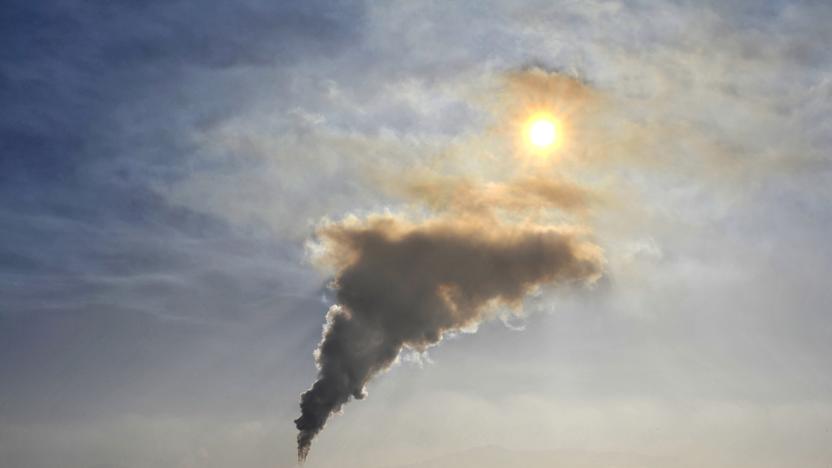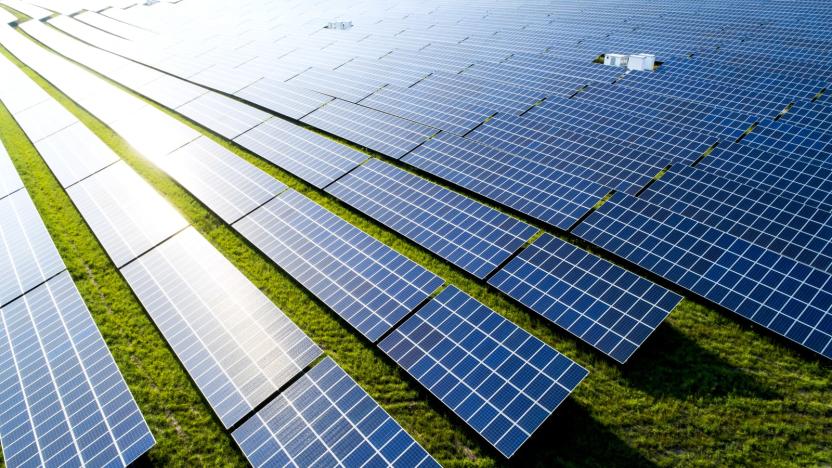clean energy
Latest

Electric airplane towing concept could mean longer zero-emission flights
Magpie Aviation announced a novel new approach to electric airplanes on Monday. Today’s battery technology (including CATL’s new, more efficient one) severely limits the practicality of zero-emission aircraft, leaving clean-energy innovators with two incomplete options: flying a plane full of batteries or one full of people — but not both. So the California-based startup wants to tie them together, extending the rear plane’s range by hundreds of miles.

Researchers can now pull hydrogen directly from seawater, no filtering required
Researchers at the University of Adelaide successfully split hydrogen and oxygen from seawater, offering new hope for cheaper and more accessible renewable energy for coastal regions.

EU wind and solar energy production overtook gas last year
A new report says wind and solar energy overtook

Study says Europe is 21 years behind its emissions reduction goals
Europe's largest utility has shared a study claiming the EU will be 21 years late on emissions goals unless it accelerates its pace.

California plans to end oil extraction by 2045
California will be the first state to end oil extraction, phasing it out by 2045.

House Democrats’ climate plan calls for 100 percent EV sales by 2035
House Democrats want to eliminate the US economy’s greenhouse gas emissions, in part by pushing for 100 percent electric passenger vehicles.

Amazon plans new solar and wind farms in Ireland and Virginia
Months after Amazon shareholders turned down a plea by employees to do more about climate change, the company announced two new renewable energy projects. Today, Amazon shared plans for a wind farm in Ireland and a solar farm in Pittsylvania County, Virginia. When completed sometime in 2020, these projects are expected to generate a combined 168,000 MWh of clean energy annually, helping Amazon reach its goal to power 100 percent of its operations with renewable power.

Gigaom checks out Apple NC data center's renewable-energy infrastructure
Images by Katie Fehrenbacher, Gigaom Apple's huge Maiden, NC, data center has recently become something else -- a net power provider of clean energy to Duke Energy. Gigaom's Katie Fehrenbacher took a look at Apple's new power-production facilities, which generate a total of 50 MW (megawatts) of electricity for a data center that uses about 40 MW of power. There's a 100-acre, 20 MW photovoltaic solar farm right next to Apple's data center, a second 20 MW solar farm about 15 miles away from the center, and a 10 MW fuel cell farm that's also adjacent to the data center. The solar farms use huge arrays of photovoltaic cells that tilt to follow the sun during the day. Grass was planted underneath the arrays, and Apple contracts with a local company to have sheep keep the grass neatly clipped (and presumably to fertilize it...). The fuel-cell farm is rather compact, and uses biogas to fuel the big cells. The fuel cells are manufactured and operated by Bloom Energy of Sunnyvale, Calif., and use a chemical reaction to convert the methane in biogas and oxygen in the air to create electricity, heat, water and CO2 as side products. All in all, Fehrenbacher's investigative report is a fascinating look at how Apple has chosen to dive into the world of clean energy production with enthusiasm.

Made in the USA: Four stories in four days
Over the past two years, the United States has seen a return to American manufacturing by some of the biggest names in tech. In 2012, Google introduced the ultimately failed Nexus Q, while Apple's Tim Cook teased an American-made Mac. One year later, Lenovo cut the ribbon on a new plant in North Carolina; Motorola announced plans for a Made in the USA flagship; and Apple made good on Cook's promise with its latest Mac Pro. However, even with President Barack Obama backing a return to American production and moves from big players like Apple and Google, the fear of skilled labor shortages persists. In the lead-up to July 4th, we'll bring you four stories in four days that explore what innovation in the United States looks like today and what that means for you. In our first installment, Jason Hidalgo sits down with theoretical physicist Michio Kaku to talk about the dangers of a Silicon Valley brain drain and building the Death Star. On day two, Darren Murph takes a tour of Babcock Ranch, the once-hopeful site of "America's most sustainable city." On day three, we'll bring you Jamie Rigg's look at tech's reshoring efforts. And on the Fourth, Brian Heater will explore how one non-profit harnessed the power of big names like Bill Gates and Jack Dorsey to help bring coding to classrooms nationwide. For more from the field and the factory floor, keep it locked here as we explore what it means to be Made in the USA. Future Soldier: Michio Kaku A Green Dream Deferred American Redux Coding is Fundamental . . . .

Inhabitat's Week in Green: solar panel printer, gold producing bacteria and a life-size of horse made of computer keys
Each week our friends at Inhabitat recap the week's most interesting green developments and clean tech news for us -- it's the Week in Green. Inhabitat is always interested in finding innovative uses for old technology, and this week we saw artists and designers from around the world produce new things from old, unused or outmoded gadgets. In Osaka, a local goldfish club has been transforming old phone booths into gigantic public fish tanks. In another large-scale art installation, Babis Panagiotidis used 18,000 recycled computer keys to make a life-size rocking horse. London artist Leonardo Ulian also makes beautiful, ornate mandalas from bits and pieces of old circuitry. And Benjamin Yates makes his unique coffee tables from recycled circuit boards, old VCRs and computer components.

Fraunhofer black silicon could catch more energy from infrared light, go green with sulfur
Generating solar power from the infrared spectrum, or even nearby frequencies, has proven difficult in spite of a quarter of the Sun's energy passing through those wavelengths. The Fraunhofer Institute for Telecommunications may have jumped that hurdle to efficiency through sulfur -- one of the very materials that solar energy often helps eliminate. By irradiating ordinary silicon through femtosecond-level laser pulses within a sulfuric atmosphere, the technique melds sulfur with silicon and makes it easier for infrared light electrons to build into the frenzy needed for conducting electricity. The black-tinted silicon that results from the process is still in the early stages and needs improvements to automation and refinement to become a real product, but there's every intention of making that happen: Fraunhofer plans a spinoff to market finished laser systems for solar cell builders who want their own black silicon. If all goes well, the darker shade of solar panels could lead to a brighter future for clean energy.

Greenpeace: Apple's energy policy has improved, still needs to remove the coal smoke from iCloud
Wondering where Apple stands environmentally after the recent withdrawal (and subsequent return) of its laptops and desktops from the EPEAT rating system? Greenpeace has issued a well-timed report, outlining the company's broader back-end energy policies. According to the organization, "Apple's clean energy policies have significantly improved, but the company still gets low scores for its energy choices when compared with sector leaders." Greenpeace applauds Cupertino's commitment to goal coal-free by next year, but wonders aloud how the company will get there, noting that while it has invested in solar and other renewable energy sources, it still buys power from outlets that rely on coal. The organization also took the time to admonish Apple's lack of transparency on its environmental plans.

First solar-geo plant blooms in Nevada's high desert
Drive west on US Route 50 through a stretch of Nevada highway known as "The Loneliest Road in America" and you'll eventually find yourself in the rural county of Churchill. Once a solitary leg in the Pony Express route, irrigation transformed swaths of Churchill's high desert areas into thriving agricultural communities more than a century ago. Fast forward to today and Churchill finds itself playing host to yet another interesting dichotomy -- a first-of-its-kind power plant that generates electricity by harvesting renewable resources from both earth and sky. %Gallery-159924%

Reported new DARPA chief brings true geek, dash of green tech controversy
Running DARPA has always demanded a certain amount of tech-savviness -- it created what ultimately became the internet, after all -- but it may get an extra coat of green paint with a new leader. The agency has reportedly taken on Arati Prabhakar as its new director, and Wired notes that she has a lot more than just the agency itself under her belt. Along with going so far as to found DARPA's Microelectronics Technology Office, she ran the National Institute of Standards and Technology (NIST) and eventually signed on with Interval Research the venture capital firm that backed the solar power company Solyndra as well as numerous other green tech projects. That last decision has drawn a fair share of flak: Solyndra got about $500 million of public funding and still went under. With that in mind, an anonymous senior military staffer claims that Prabhakar wasn't involved in the questionable government loan and went through "extensive vetting," so it's doubtful that the funding will cast the same shadow over her DARPA technology investments as it did for the outgoing director, Regina Dugan. Even so, there will no doubt be a close watch over Prabhakar if the appointment is made public, both for those who want to keep her honest as well as for the potentially huge amount of insight into clean energy and general technology that she can wield. [Image credit: SRI]

Inhabitat's Week in Green: solar-powered plane, chrome Fisker Karma and the 'blackest' solar cells ever
Each week our friends at Inhabitat recap the week's most interesting green developments and clean tech news for us -- it's the Week in Green. With the days getting longer and the spring sun creeping into the evening hours this week, we saw a host of impressive solar energy projects that put those rays to work. Kyocera revealed their plan for Japan's largest solar farm and French company Areva announced they will be building the largest solar installation in Asia. On the other side of the globe, New York City was proud to say that it recently tripled its solar power production and a new study showed that the United States pulled ahead of China in the clean energy race this year. We also saw designs for a new solar satellite that could harvest the sun's rays 24/7 and we ogled photos of the massive array of PV panels topping the zHome complex in Washington. A team at Natcore blew away the scientific community by creating the "blackest" solar cell ever designed and Panasonic gave us a sneak peek at its shimmering, solar-powered "Photosynthesis" Ecosystem installation, which will light up the night at the Milan Furniture Fair next week. In green transportation news, Justin Bieber's blindingly shiny chrome Fisker Karma had people talking (and putting on their sunglasses), while the former head of R&D at GM predicted that we'll see driverless cars by 2020. Honda announced that it is teaming up with Zipcar to provide EVs and hybrids to Zipsters and Ferrari confirmed that its future V12 models will have a new hybrid system. Finally, SolarWorld sent us news about their new Elektra solar-powered plane, which can fly twice as far as its predecessor. Smart design continued to make the world a little better with innovations like this vibrating glove that lets blind people text and Montessori's Intro to Letters app, which teaches kids the alphabet. We also got back into nature (literally) with these see-through bubble tents surrounded by trees, and we reflected upon the mysterious human-shaped mirror sculptures that popped up in a Scottish forest.

Daily Update for April 2, 2012
It's the TUAW Daily Update, your source for Apple news in a convenient audio format. You'll get all the top Apple stories of the day in three to five minutes for a quick review of what's happening in the Apple world. You can listen to today's Apple stories by clicking the inline player (requires Flash) or the non-Flash link below. To subscribe to the podcast for daily listening through iTunes, click here. No Flash? Click here to listen. Subscribe via RSS

Apple plans nation's biggest private fuel cell energy project
Apple has made several moves lately that point to it becoming one of the nation's leaders in terms of adopting clean energy technology. First, the company announced that is installing a 20-megawatt solar farm across from the Maiden, North Carolina data center. Now the Greenboro, N.C. News & Record reports that the company plans to install the largest private fuel cell energy project in America near Maiden. The project, which should be producing energy by the end of the year, will use large modular fuel cells from Bloom Energy of Sunnyvale, California. The company's "Bloom Boxes" (see photo above) are in use in a number of other fuel cell projects throughout the country, primarily in California. Fuel cells produce electrical energy from hydrogen gas through an electro-chemical process, with water being the only byproduct. They've been used on NASA spacecraft for years, and have only recently made an impact on electrical power generation. The technology is rather expensive, which is why most fuel cell installations have been made in California where the state provides incentives equal to about half of the installation cost. Apparently, the hydrogen fuel will be produced from natural gas feedstocks, with Apple hoping to offset the use of natural gas with landfill methane gas or other biogas. Bloom Boxes are being used for clean energy production by a number of other large tech firms, including Adobe, eBay, and Google.

AT&T becomes the first telco to use energy-efficient Bloom Box servers, will power 11 sites in California
Remember Bloom Energy servers, those low-cost, energy-efficient fuel cells born out of a scrapped NASA project? The company made a splashy debut last year, starting with a spot on 60 Minutes and a long list of early-adopting corporate heavyweights like FedEx, Walmart, Google, Coca-Cola, Staples, and eBay. Since then, we haven't heard much from the company, but today she's back -- AT&T says it will be the first telco to use these refrigerator-sized servers to power its operations. For now, the company's planning on using the technology to run 11 sites in California, a move AT&T says will cut its carbon dioxide emissions in half and virtually eliminate SOx, NOx, and other smog-forming particles. All told, its servers should produce 62 million kWh of power annually -- once all of these servers are fully up and running sometime in the middle of next year, that is. We say good on AT&T, though we'll really be stoked when these things start lighting up more average Joe homes.

GE announces hybrid power plant of the (near) future
GE's legacy dates back over a century, but, despite its old age, the company's got a fresh outlook on the future of energy production (at least according to its PR department). Earlier this week, the outfit announced MetCap Energy Investments' plans to build a "first-of-its-kind" hybrid power plant, tapping GE's FlexEfficiency technology, which combines natural gas, wind, and solar thermal power. The plant, planned for completion in Turkey in 2015, will produce enough energy, according to GE, to power 600,000 homes, and could lead to plant efficiency greater than 70 percent. What's more, the company promises zero liquid discharge and single-button 28-minute startup. Here's hoping this cracks up to be a better fit than NBC. Full PR after the break.

Beacon Power completing construction of 20-megawatt flywheel plant, the world's largest
Remember Beacon Power, that startup using 2,800-pound flywheels to cut noxious emissions? Well, three years later, the company is wrapping up construction of its first plant, a 20-megawatt operation that just happens to be the world's largest. The Stephentown, NY facility is home to 200 of these flywheels, which store and output energy as needed, essentially matching the power supply with the demands of the grid. The result, the company promises, is reduced energy waste and stable electrical frequencies hovering around 60Hz. And while the plant's already up and running at 18 megawatts, it won't be until later this month that Beacon finishes building it out so that it reaches its full capacity. Full PR and champagne-popping celebration plans after the break. %Gallery-125247%








